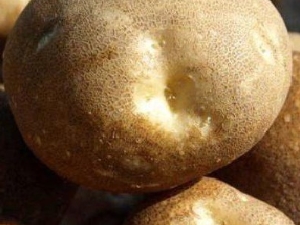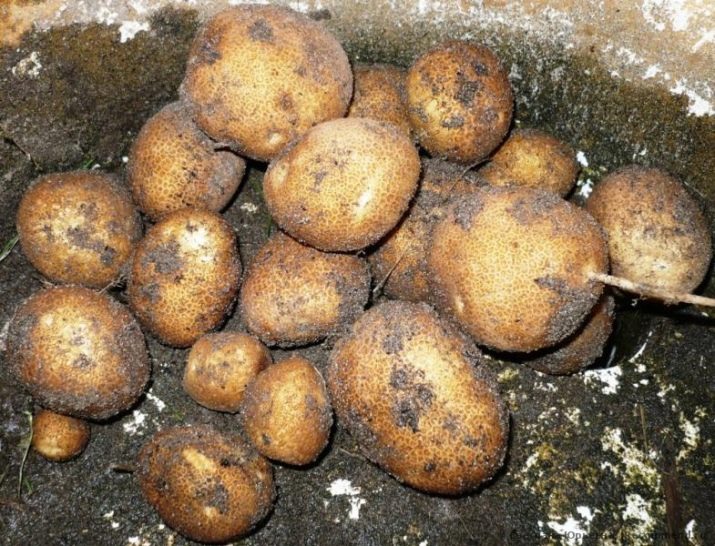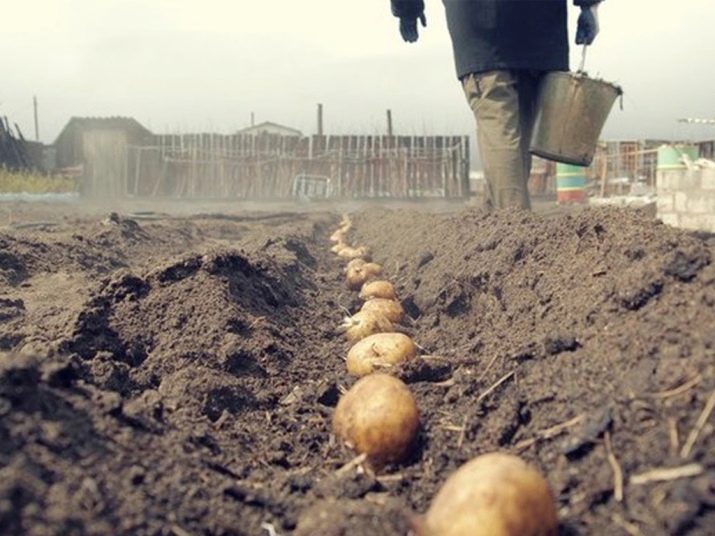Kiwi Potatoes: variety description and cultivation

The work of scientists and breeders quite often brings results that allow to improve vegetable crops, opening up new varieties to the world. Such achievements include getting a new type of potato "Kiwi", whose features are very interested in gardeners.
Characteristic
Potatoes today are the most sought-after vegetable among the cultivated crops in our country, since it is the main ingredient of most of the dishes present in the diet. Virtually every gardener is engaged in growing potatoes for personal use or for subsequent sale in the markets or in supermarkets.
Despite the widespread cultivation of potatoes, the culture requires competent care, given the characteristics of the variety. "Kiwi" is a rather exotic type of potato, which can be found not in every garden, moreover, it does not so often appear on the shelves of supermarkets. But people who appreciated his dignity, chose precisely this sort of vegetable.
Notable culture good yield and excellent resistance to diseases and pests.
The variety "Kiwi" was bred in Russia and is the fruit of amateur breeding. It was not included in the state register.
Agronomists, making a description of the variety, attribute it to mid-season crops, since it takes about 120 days from the first shoots of the bushes to the full readiness of potatoes, but when grown in a more severe climate with a cool summer, the period of ripening may increase by another week and a half.
Potatoes "Kiwi" can be planted successfully in any region of Russia, in addition, the vegetable is growing in Belarus, Ukraine, Kazakhstan.
The bushes of the plant are small, reaching a length of about 40-80 centimeters, depending on the type of soil in which the culture develops. Stems are rich in emerald green foliage. To the touch, the foliage of the variety is slightly rough with a large number of villi and with characteristic notches on the edges. The variety blooms with purple inflorescences that attract insects, therefore there are always a lot of bees and bumblebees on them.
Among the unique features of "Kiwi" is worth noting the fact that the tubers ripen always or medium or large size, small potatoes of this variety are not found.
The shape of the tubers elongated with rounded edges, the skin of the potato is thin and rough, which has earned its similarity with the exotic fruit, after which the variety is named. The flesh of tubers is white. The plant in question is distinguished by high yields — on average, With one kilogram of planting material in a suitable soil and with the condition of competent agrotechnology, you can get about 20 kilograms of potatoes.
Due to the specificity of the pulp, it will take longer to cook this variety until full readiness than others, since the potatoes are quite dense inside. As for taste, in general, the variety has positive reviews.
In addition to immunity to most diseases, tubers and tops are not destroyed by the wireworm and Colorado potato beetle. Potatoes are transportable and have a rather long shelf life, while maintaining their taste and presentation.
Is GMO or not?
Due to the fact that the potato is not threatened by the attacks of the Colorado potato beetle, there is an opinion about the genetically modified origin of the variety, information of this nature can be found quite often. But there is no evidence of this. Some agronomists also argue that the variety "Kiwi" can not have a natural origin, because it is of no interest to insects, which means it contains an artificial gene that frightens them off.
However, the opinion that it is impossible to derive a variety resistant to pests by ordinary breeding is not entirely correct, since work in this direction has already been carried out in our country. In the course of development, common and wild potatoes were crossed.True, the result of the work of scientists was the variety, which, due to its taste, was impossible to eat. But the work on this did not stop, due to which it was possible to reduce this lack of tubers to a minimum.
"Kiwi" is not of interest to insects for several reasons:
- the product has bio-cellulose, but is unable to assimilate its organism of the Colorado potato beetle and wireworm;
- due to the presence of hairs on the foliage of bushes, the beetle does not have the opportunity to lay eggs on it, so he prefers the usual varieties of vegetables.
Considering these features of potatoes, it is worth noting that they are not evidence of interference with the gene component, since biocellulose is the result of standard breeding measures, as well as features of the leaves on the bushes. In favor of the fact that the potato "Qiwi" is not genetically modified, the existence of other types of potato that are resistant to the Colorado potato beetle also says, and they were bred by traditional breeding. These include the variety "Morning" or "Kamensky."
Since the variety "Kiwi" is the fruit of amateur breeding, it is rather difficult to give a full assessment of the culture, as the potato has not been subjected to state research. Most of the product information is observations of agronomists and breeders.
Advantages and disadvantages
The main advantage of the variety is the ability to produce a high yield.
Among the rest of the list of positive features of the vegetable in question is worth noting. high resistance to pathogens Phytophthora, Alternaria, Phomosis, Scab, and many other diseases. An important quality, which should be attributed to the merits of the potato "Qiwi", is so vigorously discussed lack of interest in the vegetable culture of the Colorado potato beetle.
But like any other plant, this variety has disadvantages. These qualities of potato are the fact that it takes much longer to prepare when compared with other species. On average, it takes 40 minutes to boil the potatoes. This disadvantage is quite subjective, so it does not have a significant impact on the popularity of the variety.
In addition, even under the condition of the forty-minute cooking pulp of tubers well boiled soft which makes it a great choice for mashed potatoes or first courses. According to reviews, “Kiwi” is not recommended for frying, because in the process of such heat treatment, it burns due to the high content of dry substances, and the middle area remains raw.
How to plant?
Even taking into account the rather extraordinary appearance and the name of the potato, the scheme of its cultivation is not much different from the traditional technology of planting and care. Therefore, the implementation of mandatory measures relating to agricultural, will get a good result, even a novice gardener.
For planting potatoes matters not only the place chosen for the growth of bushes, but also the time for planting tubers. As for the regions with moderate climatic conditions, in this case the landing is carried out in April-May. In other regions, the timing of planting tubers may vary in one direction or another. In the northern regions, the soil warms up to the necessary temperatures only by June, therefore in these regions there may be some difficulties with planting the variety, since it will take at least 120 days to ripen.
Taking into account the peculiarities of the climate in various areas, planting varieties with the probability of frosts should be postponed, since insufficient heating of the soil will negatively affect crop yields.
Place for growing potatoes should be sunny with a minimum number of shaded areas. Soil for future sowing is necessary to feed in the fall. For these purposes, organic fertilizers are used, for example, manure or humus, or phosphate and potash compounds.A good effect on the growth of tubers feeding the soil with ash. It is usually introduced into the soil in spring.
As for the predecessors, then after the tomatoes, peppers or eggplant plant potatoes is not worth it. The best option would be the soil after cucumbers, beans or pumpkins.
The peculiarity of the variety is the fact that potatoes are grown exclusively by planting sprouted tubers, like most potato species, but it cannot be grown from seeds.
Considering the characteristic spreading of potato bushes, for a good harvest it is worth planting plants not too close to each other, keeping some distance between rows and bushes in the same row. The most acceptable landing pattern is 45x90 centimeters. Such an arrangement will give the potato the necessary space for growth, which will positively affect the development of tubers.
Plant a variety according to standard methods - in dug holes in sliced crests. Dutch planting technology also gives good results. It comes down to the location of the beds at a serious distance from each other. As a rule, the distance between the rows is about 75 centimeters. For a variety such as Kiwi, such planting of tubers would be most appropriate, since it provides the bushes with much-needed freedom to ripen. Choosing this option, you can abandon the standard hilling, since it will be enough to sprinkle the plants on both sides.
Based on the type of soil, one requirement should be taken into account: in light soils, the depth of the holes can reach 10 centimeters, in loam it is worth deepening the tubers by no more than 7 centimeters.
Care
After landing it is necessary to adhere to competent agrotechnology. Caring for potatoes includes the following mandatory activities:
- watering beds;
- depending on the method of planting, hilling of bushes may be necessary;
- weeding from weeds;
- top dressing.
Watering culture is carried out as needed, given the climatic conditions, but, as a rule, the potatoes have enough atmospheric moisture. Gardeners who grow this potato recommend watering three times over the summer.
The introduction of fertilizers is recommended even under the condition that the soil for planting has been prepared since autumn. Trace elements must be entered strictly adhering to the instructions, because the excess will adversely affect future harvest. To make potatoes more nourishing, nitrogen must be used to feed the bushes. Usually they fertilize the soil on the site in the fall, the second dressing should be done in May. But caution should be exercised with this trace element, since an excessive amount of nitrogen will provoke an active buildup of green mass of bushes.
Mineral fertilizers, such as phosphorus and potassium, are used for top dressing in early summer and after the onset of final warming.
Preventive treatment of pests of the variety is not needed. The only need before harvesting is to trim the tops a few days before digging out the tubers.
Diseases and pests
Since this potato variety contains bio-cellulose and has a specific structure of leaf plates, traditional pests that harm other types of potatoes are not intimidating. That is why the bushes do not need to be sprayed.
As for diseases, Kiwi has a rather serious resistance to late blight, in addition, the disease manifests itself, as a rule, closer to autumn, and at this time this variety is most often harvested.
Harvesting and storage
Tuber harvesting occurs in September, but if the summer months were not very hot, the potatoes would ripen to the desired degree a couple of weeks later. As practice shows, the tubers planted in the ground in mid-late May, usually dug closer to the 20th of September.
Harvesting is best done on a sunny day, so that after digging you can let the potatoes dry out in the open air. In cloudy weather and rain, the harvest must be placed under a canopy, but with sufficient circulation of fresh air. This will help increase the shelf life of the harvest.
Potatoes after harvesting is perfectly transportable. As for keeping quality of the variety, according to reviews of gardeners, the potato shows itself from the best side, which allows you to store the crop for quite a long time.
Such characteristics are inherent in most late-ripening varieties, which include "Kiwi", so the harvested potatoes in cool rooms will be perfectly stored all winter.
You can see rare varieties of potatoes in the next video.






































